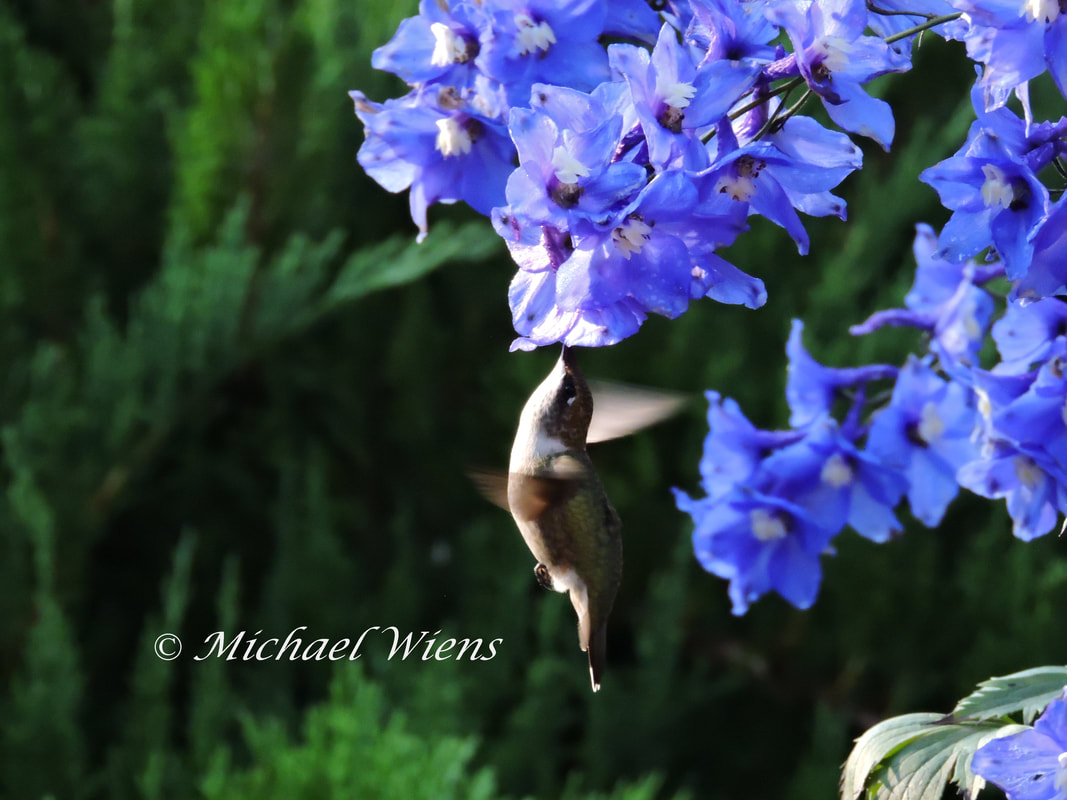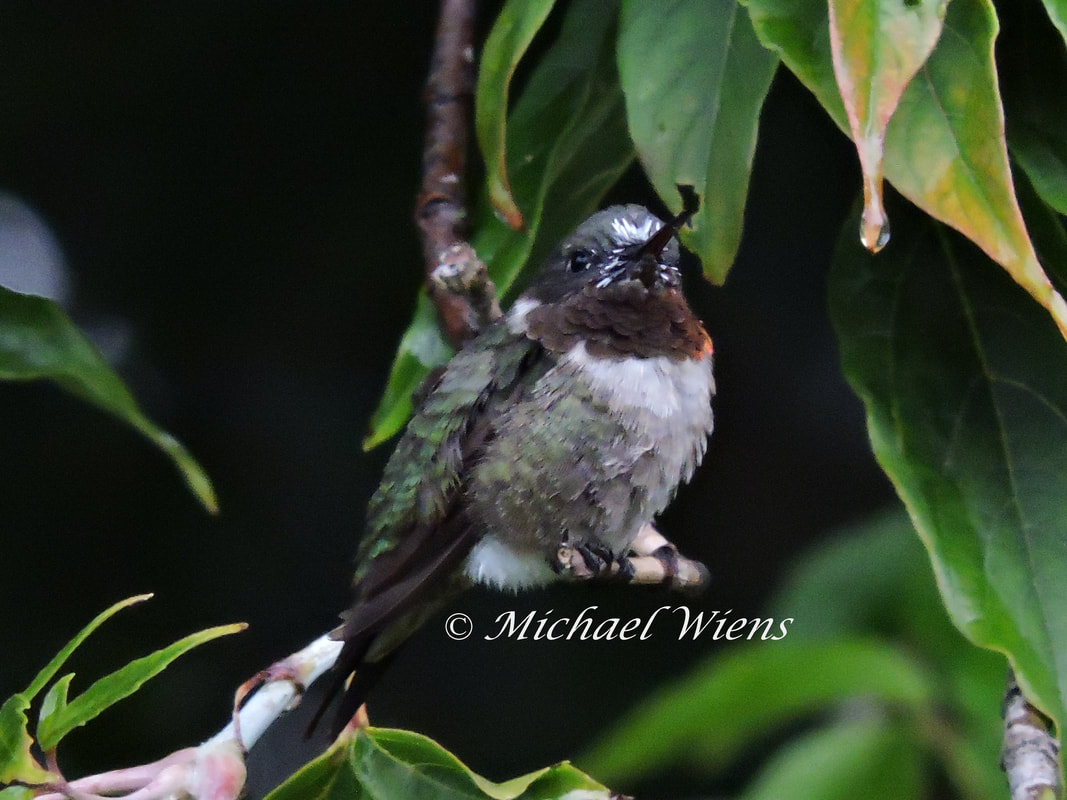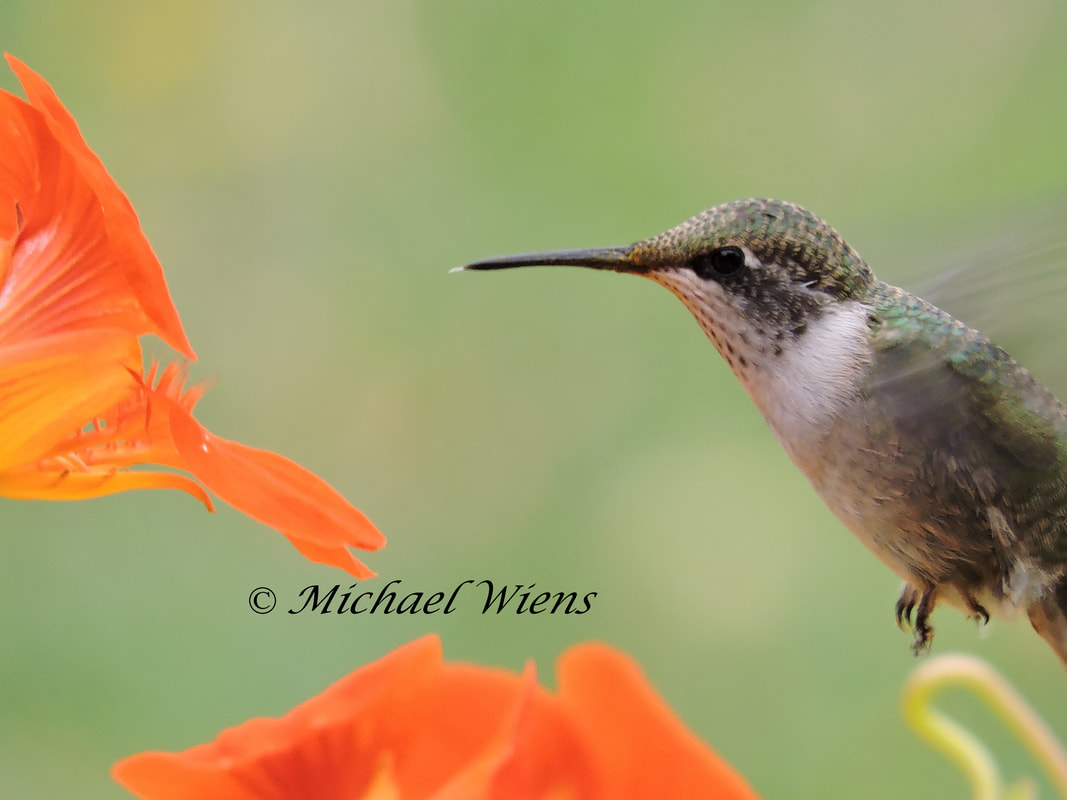Humming Blog |
 The garden began to cool as the sun slipped lower towards the horizon, so we decided to sit in another location in the garden where the warmth of the sun would finish the day. Delphiniums surrounded us on all sides, and it didn't take long for the young hummingbirds to once again begin their squabbling. It's always interesting to see the garden from a different viewpoint as you see things that you normally wouldn't. Delphiniums had grown and leaned towards the back of our garden chairs, while others surrounded us just a few feet away. Then a little dart swooped in, and the humming began. I could feel a vibration of the hum right behind my head and then a gentle tapping on my back as a young hummingbird pushed enthusiastically into the flowers to get the nectar. It's a time where you don't move or blink, but just soak up the moment to memory. Then he shifted to the flowers right in front of us. He, like all the others in the garden, fed vigorously to take in as much nectar as possible before another aggressive bird would move in for an attempted takeover. He would feed until nearly exhausted, break for a minute or two, then right back to feeding. We sat as still as possible while I captured numerous shots of him sitting on the fragile little branches and feeding away the sunset. Juvenile Ruby-throat hummingbird. N.E. of Edmonton, Alberta, Canada. August 8, 2019.
0 Comments
 This is an overview of the 2019 hummingbird season in my garden. This probably seems strange giving an overview of my garden while many of you are seeing increased numbers of them in your gardens to the South. My season is very short, only lasting about 100 days. It was another fantastic season but here's how things changed or remained from previous years. It was a dry Spring which allowed us to do plenty of work out in the garden without being pestered by hordes of mosquitoes. Then the rains came. It was wetter than average, and I'm sure it played a major part in the nesting process for the hummingbirds. Then the mosquitoes showed up, hatch after hatch, to the point where it kept us out of the garden for the next couple of months. I Anticipated having the young show up later than normal due to many days of rain keeping the mothers on the nest longer than usual. This proved to be the case as the first young showed up about 7 days later than the usual time. We also ended up getting young later than usual. Numerous pairs of young showed up spanning over a four week stretch. I would say the adult male numbers were very close to average, if not down by just a couple. The number of young birds seemed to be average or up just a slight bit. What I did notice that was quite different from previous years is the number of migrant females that stopped in, fed, and continued on through. That's one thing I was quite pleased about. My calculation of sightings was down a bit, peaking out at just over 10 sightings per minute, but I'm sure I played a part in that as I added some extra feeders in quieter locations to ease the pressure and allow some of the new younger birds a chance to feed. I didn't spot any rare Rufous or Calliope this year. On average I have between 6 and 8 adult males sticking around until they migrate. This year I'm guessing 5 or 6. It may not be completely accurate because there's an area towards the back of the garden that is now being blocked from my view due plant growth, but we definitely didn't peak out near our highest male numbers between 12 and 15 during the migration. I would say the number of young was up, which would mean the female numbers were also. The number of migrating females also seemed to be up. I would say overall we ended up in the positive, and considering the amount of rain we had, it’s good news. The time they arrived was average to slightly later than average, and the time they left was slightly later than normal, more than likely due to all the rain we had. So the overall look at the 2019 season in our garden was very close to average or even the higher end of average. There was no major noticeable decline or increase in the population, just a shift in the numbers at different times. No decline means no need to be alarmed. The weather was on the cooler side this year, with more rain than normal. This is the last capture I have of Ziggy, my adult male Ruby-throat. He lost all desire to chase, but continued to sit over his feeder and protect it. He's in full molt as you can see by his porcupine face. August 8, 2019. N.E. of Edmonton, Alberta, Canada.  For the last few days one lone juvenile Ruby-throat has taken control of our garden since he's had no competition to worry about. He's made the trek to surrounding yards up to 1/2 mile away, but returns quickly to his home base to refuel. His behavior has been different from others due to the fact he had no others to compete with. He's fed when desired, and didn't need to fight for his food. He wasn't vocal because there weren't others to heed the warning. Life just seemed quite easy for him. I thought to my self over the past few days of how he would react if another were to show up. He too is quite young, so I wondered how he'd react since he didn't have the bully behavior taught to him. Would he be possessive of the garden, or would he remain submissive because his anger hasn't been tested yet? I thought about the good year we had and then dropped my head in thanks, and with my eyes closed I was interrupted by a sound resembling a card in the bike spokes. I lifted my head and looked around. My movement must have startled a young male that was now about 20 feet away in the Nasturtiums. I knew immediately it was another young male. It only took him about 30 seconds before he flew right back in front of me into the other Nasturtiums. I realized the sound was now this clumsy little fellow fumbling around in the plants. His wings continued to slap the petals of the flowers as he dug deep for the nectar. So many moments made me silently chuckle, and sometimes out loud, as he'd grab hold anywhere possible and fall into the tangled vines of the Nasturtiums. I watched and listened to the high speed flutter of wings slapping his way out of a troubling mess of vines. He wasn't graceful in any way, and certainly eager and pleased to find a garden full of flowers. His vigor made me think that food must have been at a minimum in his travels. I then thought about the other young male. I wondered if he knew of this little intruder? Within seconds instinct kicked in. He came like lightning out of the trees and a chase immediately started. Up and over the trees, and who knows how far they traveled. Within a few minutes the dominant one returned to a feeder. I wondered if the other would be back or if fear sent him packing to a warmer climate. Sure enough, within 15 minutes the newbie came back to the food he knew and once again fumbled in the flowers. Imaged is the Newbie. He's a young male Ruby-throat. N.E. of Edmonton, Alberta, Canada. Aug 30, 2019. |
Archives
June 2024
Categories
All
|
 RSS Feed
RSS Feed
